There is a saying that hindsight is 20/20, but when it comes to the stock market I don’t think that’s necessarily true: even after seeing a stock’s price move, you might never square away why in your head. Plus, of course, there are so very many ways to drive yourself stark raving mad by constantly looking back at all the coulda-woulda-shoulda moments the market provides. Don’t beat yourself up about past mistakes is one of my dad’s pieces of advice, don’t worry about what happened in the past since you can’t change it, and the market will be offering up another opportunity if you look for it. There are many times when I wish I had a time machine to go back and do something differently, and I try not to dwell and obsess since it is far too easy to do both. However, I can’t help but feel that since I still have so much to learn, that it couldn’t hurt to look back and see where I went wrong. I already had one brief retrospective back in January, so let’s start by following up from there.
Then, I talked about falling knives, and boy, did the bank stocks fall in March when Bear Sterns went under. I came seriously within one mouse click of buying some TD that day, but was afraid (stupid emotions!) of repeating my knife-catching mistake, so I called my dad for some sober second thought. He said to just steer clear of the whole sector since there was so much uncertainty, and that there was no real way to know how liquid or profitable any of the banks really were in these times. Even though I thought TD was a quality bank that was being sold off due to fear, I wasn’t sure, and started to fear myself that such a big downswing must be for a reason, and that maybe somewhere out there was a group of investors who knew more than me, so I steered clear, and still haven’t bought in, as much as I’ve been kicking myself for it the last few days as the whole banking sector seems to be recovering. Taking advantage of other people’s emotional selling is supposed to be what I was all about, and I missed what might have been the biggest deal (that I was actually close to making) of my investing career. Of course, my dad was not completely wrong either: there was risk there, and if TD had come out the next day saying that it was the next Bear Sterns, I could have lost it all.
Russel Metals, the falling knife I mentioned in that previous post, has come back nicely. Quite nicely, in fact. While my timing was not great, I did buy what I considered a quality company at a value price. From the broker reports I read on it and my own crude attempt to value the company, I figured that in a year or two, it would be up to $30 — 25% gain on top of a 7% dividend in a year or two would be very decent indeed. It turned out to be much better than that, hitting $30 this week, so I decided to sell. I might be making yet another mistake in shooting the running horse, but I think, today, that I’ve gotten my full value out of RUS and it might just stagnate for the next year or two from this point (or, correct to a point where I can get back on and ride the pony again). While I could have made almost twice as much by having better timing back in January, that buy doesn’t look to be such a big mistake any more.
The big thing I wish I could go back in time to buy is oil. I’ve been talking about peak oil for years yet somehow, that never translated into thinking about actually investing in oil. Even just a few months ago when I was looking at possibly investing in Petro-Canada, I was thinking more about the looming recession in the states and a possible short-term downturn in the price of oil than the 10-year gain peak oil thinking would lead me to. Of course, now oil (and PCA) has had a huge run-up in just the last few months, and again I’m waffling about whether or not to invest in it (and, again, what form an investment in oil should take: I don’t know how to just buy a few barrels at the mercantile exchange, and am not sure if I should look at an ETF like TSE:XEG or a single company like Petro-Canada). I think there’s a good chance of a correction in the next few months, especially if Nigeria and the middle east settle down for a little bit. However, I think in the long term that’s not necessarily going to matter so much, and even buying at these record prices might be a real bargain 10 years down the road. A third option is to try to avoid the necessity of timing the market (whether I want to or not) with a lump-sum investment in one company or ETF by instead buying into the TD mutual fund for energy, which has a low minimum investment (~$100), so I can just keep buying as oil goes up or down, and don’t risk either missing what good times are left, or any bargains to come. Unfortunately, that mutual fund is not an “e-series” one, and the 2% MER is not very appealing.
In a similar vein, my dad and I were talking a few months ago about “big concept” investments for the long term. One “theme” that we both agreed would be very big in the years to come was the development of China and India. Specifically, in terms of their diets. As the people of those countries found themselves feeling wealthier, they would want to expand their diets to include more high-quality, fertilizer-intensive food, including meat. So we looked for companies to invest in that would be in a good position to make money off of the demand for fertilizers to come. The big name in the business is of course Potash Corp. of Saskatchewan, which we quickly determined was not “value priced” at $100/share and a P/E of something over 25 at the time. Instead, we looked at a smaller “potash producer” in China (but listed on the TSE) called Migao. Not 6 months later, and my dad looks like a freaking genius as potash prices hit incredible new records due to demand in China, and Potash Corp. of Saskatchewan has just about doubled in price. Of course, getting the idea, the “investment theme” right doesn’t always lead to riches as we found out: Migao is down 15% in that time, and neither of us own Potash. There were two things working against Migao, and one of them we should have forseen if we had done our due diligence properly. You see, Migao is in the fertilizer business, and it does sell potash products. However, unlike Potash Corp. of Saskatchewan, Migao doesn’t actually dig the potassium-based chemical out of the ground and sell it to put on crops. That digging it and selling it business is a sweet deal when prices rise this quickly due to demand, because the cost to dig it up is basically fixed, so the unprecedented increase is pretty much all profit. No, Migao buys potash fertilizer (from a company in Russia mostly) and chemically refines it further for specialty applications. When prices go up like this, it has the potential to hurt their bottom line. Somehow, I didn’t catch that little detail when looking at the company, which I’m sure either demonstrates a valuable lesson about how important really doing your homework in the stock market is, or about how you can never really predict how well a company can do (I think probably more the former). As it turns out, Migao has basically a fixed percentage mark-up on its potash products, so it is managing to pass along the increased cost of potash to its customers and is making more money off the potash craze (though not to the degree POT is). That still makes one wonder why the stock price is down then, when they’re making more money. I don’t have a good answer to that, though it may be due to rumours that the Chinese government may, in light of the emerging food crisis, put a cap on Migao’s profiteering. That could be worrying, but I couldn’t even find a source for those rumours. So anyway, be sure to add POT to my basket of stocks to buy with that time machine.
Priszm, which I mentioned as looking decent near $6 in February has had a bit of a roller-coaster ride. Right after that post, QSR moved up to above $7, and then slid back down to $5 where it sits now. I honestly can’t figure that one out. The company is really not doing all that great, admittedly, but it was paying out 20% at $6. That was of course due to the risk premium investors would demand since, as the company is not doing great, there is a good chance that distribution will be trimmed down. However, at $5/share the current distribution is more like 24% — even if the future payout is cut in half, that’s still a 12% return, and I think it’s more likely that the distribution will only be trimmed by about a quarter (to 18% for someone buying in at $5). As much as I have trouble understanding why it might be so low, I’m not tempted to buy any more since I already have quite a bit. I might wish I had sold at $7 (to buy back at $5) with that time machine, but I think holding it for longer has not been a terrible move… yet. I’ll be sure to revisit this one in my next time machine retrospective post in the months to come.
Finally, the index funds are doing quite well for the most part, because, well, the stock markets in Toronto and New York are recovering. At least they don’t require this much work and second-guessing!



 Questrade: ETFs are free to trade, and if you sign up with my link you'll get $50 cash back (must fund your account with at least $250 within 90 days).
Questrade: ETFs are free to trade, and if you sign up with my link you'll get $50 cash back (must fund your account with at least $250 within 90 days).  Passiv is a tool that can connect to your Questrade account and make it easier to track and rebalance your portfolio, including sending you an email reminder when new cash arrives and is ready to be invested.
Passiv is a tool that can connect to your Questrade account and make it easier to track and rebalance your portfolio, including sending you an email reminder when new cash arrives and is ready to be invested.